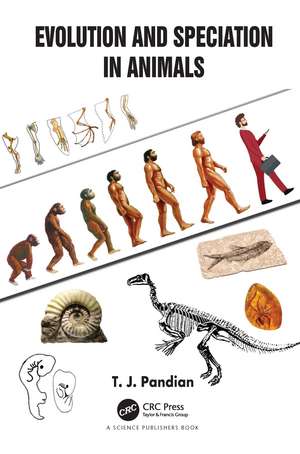Evolution and Speciation in Animals
Autor T. J. Pandianen Limba Engleză Paperback – 25 sep 2023
Selfing hermaphrodites (0.9%), parthenogens (< 0.6%) and clonals (~ 2%) miss meiosis and/or fertilization. Unable to tolerate them together, animals mutually eliminate parthenogenesis and hermaphroditism as well as parthenogenesis and cloning from each other. In clonals, colonial budding (94%) is more common than costlier fragmentation in solitary clonals. The newly proposed hypothesis explains that each stem cell plays an additive role and the required mass of stem cells differs for cloning and regeneration.
Incidence of heterogamety is four-times more in males than in females. Hence, evolution is more a male-driven process. Egg size is determined by environmental factors, but lecithality is genetically fixed. In poikilotherms, sex is also determined by gene(s), but differentiation by environmental factors. The extra-ovarian vitellogenesis (> 96%), spermatozoan (81%) rather than spermatophore mechanism of sperm transfer, promiscuity and polygamy over monogamy, iteroparity (99.6%) over semelparity and internal fertilization (84%) are preferred, as they accelerate diversity. Body size and egg size determine fecundity. Indirect life cycle (82%) and incorporation of feeding larval stages accelerate diversity. Brooding and viviparity (6.4%) decelerate it. Parasitism extends life span and liberates fecundity from eutelism.
Evolution is an ongoing process, and speciation and extinction are its unavoidable by-products. The in-built conservation mechanism of reviving life after a sleeping duration has been reduced from a few million years in microbial spores to a few thousand years in plant seeds and a few hundred years in dormant eggs in animals. Hence, animal conservation requires priority. The existence of temperature-resistant/insensitive individuals, strains and species shall flourish during the ongoing global warming and earth shall continue with such burgeoning species, hopefully inclusive of man.
| Toate formatele și edițiile | Preț | Express |
|---|---|---|
| Paperback (1) | 446.27 lei 3-5 săpt. | +21.98 lei 7-11 zile |
| CRC Press – 25 sep 2023 | 446.27 lei 3-5 săpt. | +21.98 lei 7-11 zile |
| Hardback (1) | 1114.54 lei 6-8 săpt. | |
| CRC Press – 23 sep 2021 | 1114.54 lei 6-8 săpt. |
Preț: 446.27 lei
Preț vechi: 485.08 lei
-8% Nou
Puncte Express: 669
Preț estimativ în valută:
85.40€ • 89.57$ • 71.09£
85.40€ • 89.57$ • 71.09£
Carte disponibilă
Livrare economică 11-25 martie
Livrare express 25 februarie-01 martie pentru 31.97 lei
Preluare comenzi: 021 569.72.76
Specificații
ISBN-13: 9781032009209
ISBN-10: 1032009209
Pagini: 346
Ilustrații: 88 Tables, black and white; 47 Line drawings, black and white; 11 Halftones, black and white; 58 Illustrations, black and white
Dimensiuni: 156 x 234 x 24 mm
Greutate: 0.49 kg
Ediția:1
Editura: CRC Press
Colecția CRC Press
Locul publicării:Boca Raton, United States
ISBN-10: 1032009209
Pagini: 346
Ilustrații: 88 Tables, black and white; 47 Line drawings, black and white; 11 Halftones, black and white; 58 Illustrations, black and white
Dimensiuni: 156 x 234 x 24 mm
Greutate: 0.49 kg
Ediția:1
Editura: CRC Press
Colecția CRC Press
Locul publicării:Boca Raton, United States
Cuprins
General Introduction. ENVIRONMENTAL FACTORS. Spatial Distribution. Coevolution and Diversity. Food and Feeding Modes. LIFE HISTORY TRAITS: B1: SEXUALITY. Gonochorism and Males. Hermaphroditism and Selfing. Parthenogenesis and Unisexualism. Clonals and Stem Cells. B2: GAMETOGENESIS AND FERTILIZATION. Mitosis and Meiosis. Oogenesis and Vitellogenesis. Spermatogenesis and Spermatophores. Female- vs Male-Heterogamety. Eutelism and Parasitism. Monogamy vs Polygamy. Semelparity vs Iteroparity. Spawning and Oviposition. Fertilization Success. Fecundity. B3: EMBRYOGENESIS AND DEVELOPMENT. Direct and Indirect Life Cycle. Brooding and Viviparity. Feeding and Non-feeding Larvae. Parasites and Hosts. Sex Determination and Differentiation. Metamorphosis and Recruitment. PAST, PRESENT AND FUTURE. Message From Fossils. Conservation. Climate Change.
Notă biografică
Recipient of the S.S. Bhatnagar Prize, the highest Indian award for scientists, one of the ten National Professorships, T.J. Pandian has served as editor/member of editorial boards of many international journals. His books on Animal Energetics (Academic Press) identify him as a prolific but precise writer. His five volumes on Sexuality, Sex Determination and Differentiation in Fishes, published by CRC Press, are ranked with five stars. He has authored a multi-volume series on Reproduction and Development of Aquatic Invertebrates, including the volumes on Crustacea, Mollusca, Echinodermata and Prochordata, Annelida, Platyhelminthes and Minor Phyla have been published.
Descriere
The relatively more motile major phyletics have evolved more toward species diversity, while the relatively low motile or sessile minor phyletics have gone for more phylum diversity. Interestingly, the non-motile plants and microbes have also moved toward strain/racial diversity within a species rather than species diversity.
